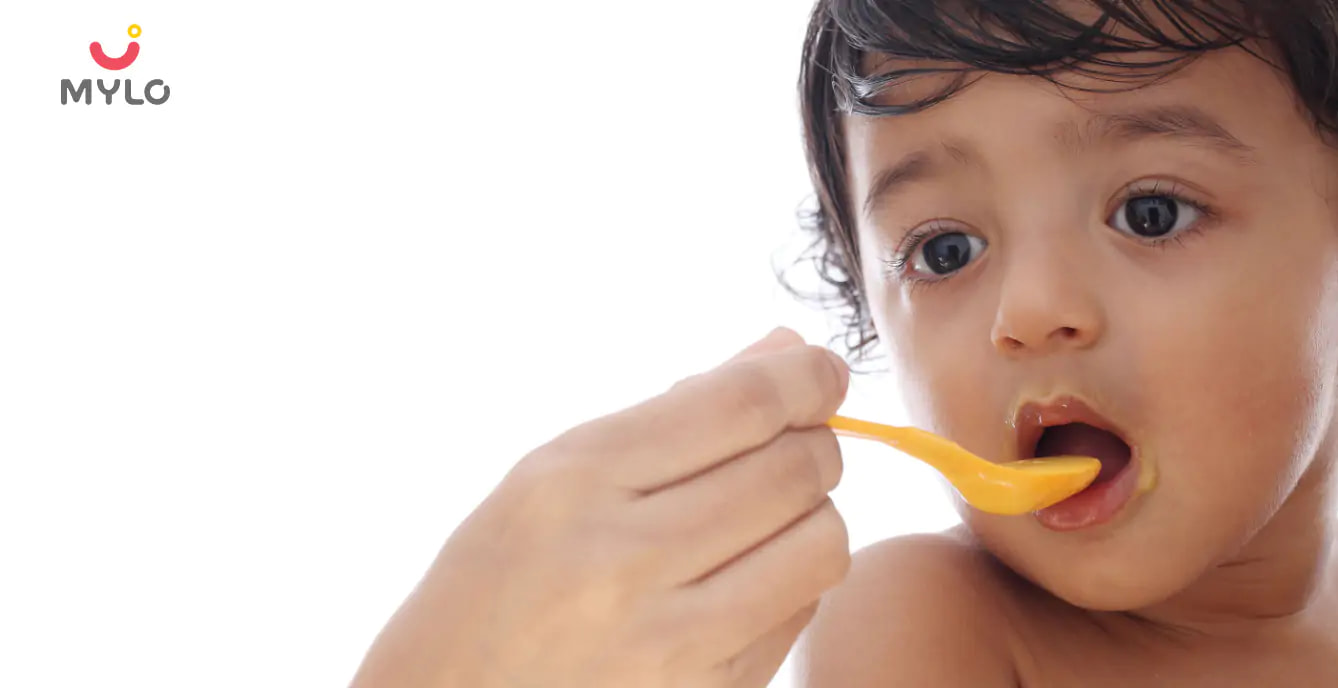- Home

- Care for Baby

- Baby Feeding: How Much & How Often Should You Feed Solids to Your 6-Month-Old Baby?
In this Article

Care for Baby
Baby Feeding: How Much & How Often Should You Feed Solids to Your 6-Month-Old Baby?
Updated on 3 November 2023
If you have an infant, you know feeding time can be a juggling feat – you're trying to figure out the amount and type of food, the schedule, and so on. When it comes to solid foods, it can be even more confusing.
There are many contrasting opinions about baby feeding and how and when to introduce solids into their diet. This blog post will demystify baby feeding and give you the best guidelines to follow during feeding.
Why and When Should You Consider Solid Foods For Your Baby?
It is recommended that babies should be exclusively breastfed for the first six months. After that, you can introduce solid foods. However, every baby is different. Some babies may be ready for eating solid foods sooner than six months, while others may not be ready even until after six months.
If you're not sure whether your baby is ready or not, there are a few things you can look for.
1. Sign that your baby is ready for solid food
Most babies ready to eat solid foods will be able to sit up with minimum support and have good head control. They will also be able to move their tongue back and forth and show an interest in tasting foods.
2. Healthy eating habits
Starting your little one on solids is an exciting milestone! Not only is it a chance for your baby to try new tastes and textures, but also a chance to develop healthy eating habits.
3. Provide optimum nutrition
There are many benefits to introducing solid foods, both for your baby and for you as a parent. For starters, it can help your baby develop a healthier appetite and sleep patterns. It can also give them the nutrients needed to grow and develop properly. And, of course, it's an amazing opportunity for you to bond with your baby and create special memories.
Also read: Baby Diet Chart: What to Feed Your Baby From Birth to 1 Year?
Talk to your paediatrician before starting your baby on solid foods. They can help you figure out the best time to start and what foods are best for your baby.
How Much And How Often to Feed Your Baby
At first, you may only want to offer a small amount of food, such as a teaspoon or two, once or twice a day. As your baby gets older and becomes accustomed to eating solid foods, you can increase the amount and frequency.
It's also important to pay attention to your baby's cues. If they seem hungry, offer them more food. If they turn their head away or refuse to eat, that's a sign they're full. Listen to your baby's body language and let them eat as much or as little as they want. Keep the following pointers in mind while baby feeding.
1. Continue milk
Continue feeding baby milk along with solid foods. This can include four to six nursing sessions. The baby will need approximately a litre of milk daily.
2. Start slowly
Begin the transition with soft, semi-solid foods like cereals or fruit/vegetable puree.
3. Introduce proteins
Once they start accepting semi-solids, you can give them small teaspoons of proteins like meat and fish. Make sure the protein is light for digestion and perfectly minced.
Read: Feeding Tips and Healthy Food Ideas for Your 7-9 Month Old Baby
4. Avoid large food items
Avoid large food items like carrot chunks, or peanuts, that may cause choking. Even if the food item is soft, there can be the risk of your baby swallowing it without chewing.
5. Cow milk only after 1 year
There's no need to include cow's milk initially. It is best to continue breast milk for a few months more. You may, however, begin dairy products with small amounts of curd and soft cheese.
6. Three solid meals initially
From 6 to 8 months, it is best to keep the baby feeding session for up to three meals for solids. This would include 4 to 9 tablespoons of solid food, including fruits, vegetables, and cereals.
Baby Feeding Routine for a 6-month-old Baby
The baby's feeding routine will depend on the infant's nap schedule and appetite. At 6 months old, most babies sleep for 12 to 15 hours per day. Each nap can last up to 3 hours.
- Babies can feel hungry after a long nap. Keep your baby's feeding bottle handy as soon as they wake up.
- Babies also tend to sleep for long if they are fed before sleep time.
- While you must remain consistent with breast milk sessions, you can start solid foods in breakfast, lunch, and dinner.
- You can breastfeed before and after the baby's nap time, based on their sleep schedule.
It's Time to Start Solids!
In conclusion, giving your baby the appropriate amount of food according to their age is essential. For a 6-month-old baby, you should be feeding them around 2 to 3 meals of solid foods every day. If you have any questions or concerns, discuss them with your child's paediatrician.
For more great tips on baby care, follow Mylo Family today.
References
1. Clayton, H. B., Li, R., Perrine, C. G., & Scanlon, K. S. (2013). Prevalence and Reasons for Introducing Infants Early to Solid Foods: Variations by Milk Feeding Type. PEDIATRICS,
2. Kuo, A. A., Inkelas, M., Slusser, W. M., Maidenberg, M., & Halfon, N. (2011). Introduction of Solid Food to Young Infants. Maternal and Child Health Journal,

2-in-1 Baby Feeding Sipper Bottle (Lion) - 125 ml
BPA Free with Anti-Colic Nipple & Spoon | Feels Natural Baby Bottle | Easy Flow Neck Design
₹ 143

4.3
(8336)


7852 Users bought



Written by
Priyanka Verma
Priyanka is an experienced editor & content writer with great attention to detail. Mother to an 11-year-old, she's a ski
Read MoreGet baby's diet chart, and growth tips

Related Articles
Related Questions
Hello frnds..still no pain...doctor said head fix nhi hua hai..bt vagina me pain hai aur back pain bhi... anyone having same issues??

Kon kon c chije aisi hai jo pregnancy mei gas acidity jalan karti hain... Koi btayega plz bcz mujhe aksar khane ke baad hi samagh aata hai ki is chij se gas acidity jalan ho gyi hai. Please share your knowledge

I am 13 week pregnancy. Anyone having Storione-xt tablet. It better to have morning or night ???

Hlo to be moms....i hv a query...in my 9.5 wk i feel body joint pain like in ankle, knee, wrist, shoulder, toes....pain intensity is high...i cnt sleep....what should i do pls help....cn i cosult my doc.

Influenza and boostrix injection kisiko laga hai kya 8 month pregnancy me and q lagta hai ye plz reply me

Related Topics
RECENTLY PUBLISHED ARTICLES
our most recent articles

Diet & Nutrition
গর্ভাবস্থায় আলুবোখরা: উপকারিতা ও ঝুঁকি | Prunes During Pregnancy: Benefits & Risks in Bengali

Diet & Nutrition
গর্ভাবস্থায় হিং | ঝুঁকি, সুবিধা এবং অন্যান্য চিকিৎসা | Hing During Pregnancy | Risks, Benefits & Other Treatments in Bengali

Women Specific Issues
স্তনের উপর সাদা দাগ: লক্ষণ, কারণ এবং চিকিৎসা | White Spots on Nipple: Causes, Symptoms, and Treatments in Bengali

Diet & Nutrition
গর্ভাবস্থায় পোহা: উপকারিতা, ধরণ এবং রেসিপি | Poha During Pregnancy: Benefits, Types & Recipes in Bengali

Diet & Nutrition
গর্ভাবস্থায় মাছ: উপকারিতা এবং ঝুঁকি | Fish In Pregnancy: Benefits and Risks in Bengali

Diet & Nutrition
গর্ভাবস্থায় রেড ওয়াইন: পার্শ্ব প্রতিক্রিয়া এবং নির্দেশিকা | Red Wine During Pregnancy: Side Effects & Guidelines in Bengali
- ইনার থাই চ্যাফিং: কারণ, উপসর্গ এবং চিকিৎসা | Inner Thigh Chafing: Causes, Symptoms & Treatment in Bengali
- গর্ভাবস্থায় ব্রাউন রাইস: উপকারিতা ও সতর্কতা | Brown Rice During Pregnancy: Benefits & Precautions in Bengali
- Velamentous Cord Insertion - Precautions, Results & Safety
- Unlock the Secret to Flawless Skin: 7 Must-Have Qualities in a Face Serum
- Unlock the Secret to Radiant Skin: How Vitamin C Serum Can Transform Your Complexion
- Gender No Bar: 10 Reasons Why Everyone Needs a Body Lotion
- Unlock the Secret to Radiant Skin How to Choose the Perfect Body Lotion for Your Skin Type
- Top 10 Reasons to Apply a Body Lotion After Every Bath
- Communication in Toddlers: Milestones & Activities
- How to Improve Vocabulary for Toddlers?
- A Comprehensive Guide to Understanding Placenta Accreta
- Vulvovaginitis in Toddlers Causes, Symptoms and Treatment
- A Comprehensive Guide to Understanding Cerebral Palsy in Children
- Bitter Taste in Mouth During Pregnancy: Understanding the Causes and Remedies


AWARDS AND RECOGNITION

Mylo wins Forbes D2C Disruptor award

Mylo wins The Economic Times Promising Brands 2022
AS SEEN IN
















- Mylo Care: Effective and science-backed personal care and wellness solutions for a joyful you.
- Mylo Baby: Science-backed, gentle and effective personal care & hygiene range for your little one.
- Mylo Community: Trusted and empathetic community of 10mn+ parents and experts.
Product Categories
baby carrier | baby soap | baby wipes | stretch marks cream | baby cream | baby shampoo | baby massage oil | baby hair oil | stretch marks oil | baby body wash | baby powder | baby lotion | diaper rash cream | newborn diapers | teether | baby kajal | baby diapers | cloth diapers |








